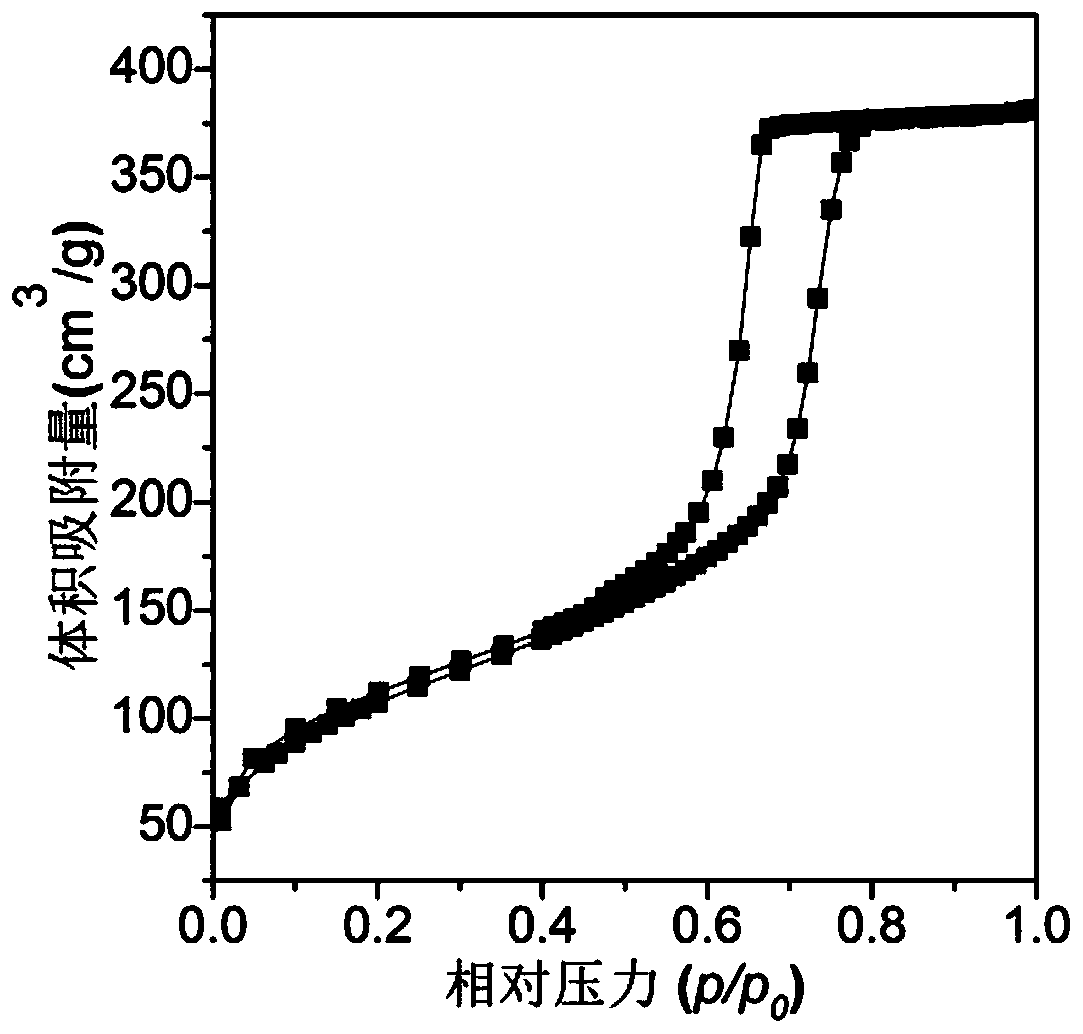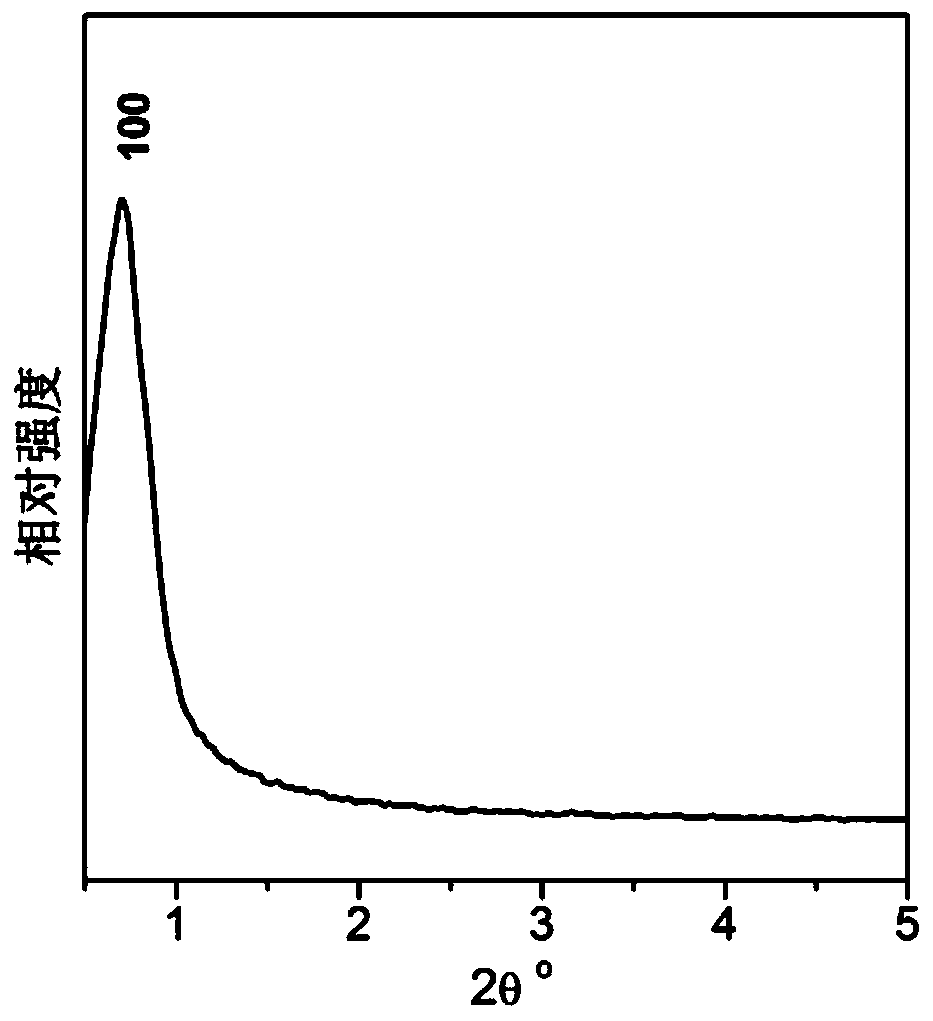Palladium-supported mesoporous carbon-silicon dioxide catalyst material as well as preparation method and application
A technology of silica and catalysts, which is applied in catalyst activation/preparation, metal/metal oxide/metal hydroxide catalysts, physical/chemical process catalysts, etc., and can solve problems such as catalyst performance verification and unused functionalized catalysts , to achieve the effect of high yield, low cost and excellent structure
- Summary
- Abstract
- Description
- Claims
- Application Information
AI Technical Summary
Problems solved by technology
Method used
Image
Examples
Embodiment 1
[0041] Put 6.0g of phenol in a three-necked flask and heat it in a water bath at 50°C to make it a transparent liquid; prepare 3.70g of sodium hydroxide solution with a mass percentage of 20%, and slowly drop it into the liquid. After 10 minutes, 15.0 g of formaldehyde solution with a mass percentage of 37% was added, refluxed at 90° C. for 1 hour, cooled to room temperature, and adjusted to neutral pH. Distill under reduced pressure at 45-50° C. to obtain the residue as the target product phenolic resin. After cooling to room temperature, the ethanol or ether solutions of the phenolic resin prepolymer with a mass percent concentration of 20-45wt% are respectively prepared for use.
Embodiment 2
[0043] At 40-60°C, 2.0g of F127(EO 106 PO 70 EO 106 ) surfactant was dissolved in 10.0 g of dichloromethane solution, then 1 g of 0.4 mol / L hydrochloric acid solution was added, and stirred for pre-hydrolysis for 1 hour to obtain solution A. At the same temperature, 3.0 g of ethyl orthosilicate and 1.2 g of N,N-bis(3-trimethoxysilylpropyl)urea were successively added to 10.0 g of dichloromethane solution, and stirred for 1 hour to obtain solution B. After solution A and solution B were mixed, 20 wt% of the phenolic resin synthesized in step 1 was added, and magnetically stirred for 4 hours. A clear, pale yellow transparent solution was obtained. Spread the above solution evenly on the surface of the glass petri dish, let it stand at room temperature for 2 hours, then raise the temperature to 100°C for 24 hours, and scrape off the light yellow transparent film, which is the prefabricated material.
[0044] The obtained prefabricated material was calcined with an inert prote...
Embodiment 3
[0046] At 40-60°C, 2.0g of P123(EO 20 PO 70 EO 20 ) surfactant was dissolved in 10.0 g of tetrahydrofuran solution, and then 1 g of 1 mol / L hydrochloric acid solution was added, and stirred for pre-hydrolysis for 1 hour to obtain solution A. At the same temperature, 3.6 g of propyl orthosilicate and 1.0 g of 3-ureidopropyltriethoxysilane were successively added to 10.0 g of tetrahydrofuran solution, and stirred for 1 hour to obtain solution B. After solution A and solution B were mixed, 20 wt% of the phenolic resin synthesized in Example 1 was added, and magnetically stirred for 4 hours. A clear, pale yellow transparent solution was obtained. Spread the above solution evenly on the surface of the glass petri dish, let it stand at room temperature for 2 hours, then raise the temperature to 100°C for 24 hours, and scrape off the light yellow transparent film, which is the prefabricated material. The prefabricated material was calcined with an inert protective gas at 400°C fo...
PUM
| Property | Measurement | Unit |
|---|---|---|
| specific surface area | aaaaa | aaaaa |
| pore size | aaaaa | aaaaa |
| size | aaaaa | aaaaa |
Abstract
Description
Claims
Application Information
 Login to View More
Login to View More - R&D
- Intellectual Property
- Life Sciences
- Materials
- Tech Scout
- Unparalleled Data Quality
- Higher Quality Content
- 60% Fewer Hallucinations
Browse by: Latest US Patents, China's latest patents, Technical Efficacy Thesaurus, Application Domain, Technology Topic, Popular Technical Reports.
© 2025 PatSnap. All rights reserved.Legal|Privacy policy|Modern Slavery Act Transparency Statement|Sitemap|About US| Contact US: help@patsnap.com



